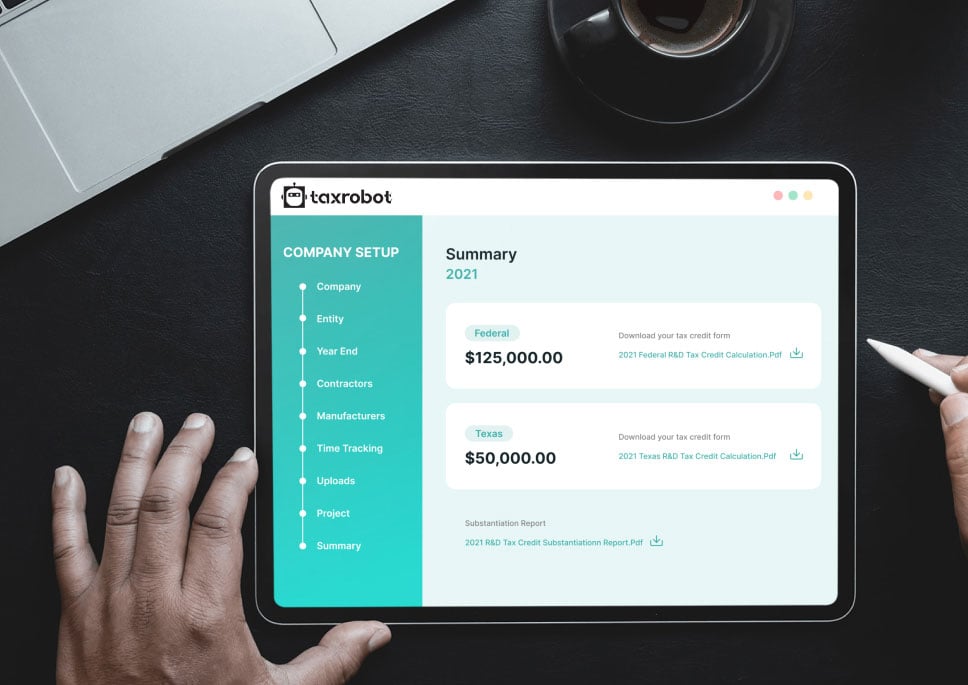Kansas R&D Credit
With Tax Robot, Kansas R&D Tax Credit becomes more than a benefit—it becomes a catalyst for your business growth. Unleashing the incredible, simplifying the complex. This is not just tax planning; it’s financial evolution.
Maximize your State Credits today!
Put the R&D tax credit process on autopilot.
Trusted By:








Kansas R&D Credit
Optimize your tax savings with the Kansas R&D credit and TaxRobot.
Are There R&D Credits Available in Kansas?
Kansas has several programs to encourage businesses to keep doing business within the state. One of these is a complex tax credit program. So, yes, there are R&D credits available in Kansas. Programs like these have placed Kansas in the upper half of business-friendly states.
In fact, when it comes to tax credits in Kansas, there are more now than there ever were. After a recent expansion, the entire process has become more rewarding than ever before. Starting in 2023, many more companies and individuals will be able to apply for the Kansas R&D credit, and they will be able to get more out of it.
Kansas Research and Development Credit
The Kansas research and development credit is an income tax credit rewarded based on expenses related to R&D. It is specifically meant to be for expenses that eliminate technical uncertainty when developing or improving products and services.
For years up to 2022, the credit is 6.5% of the increase in qualified expenses for the year when compared to the average of the previous two years. However, in tax year 2022, this amount has been increased to 10%.
This makes the credit incredibly valuable for all types of businesses. Small businesses should use it in their business plans, and large businesses should take steps to ensure they align with the requirements.
Federal R&D Credit
The other R&D tax credit available in Kansas is the federal R&D tax credit. This credit is given out by the federal government to reward qualifying expenses.
It is a credit based on the amount of qualifying expenses over the base amount. The larger the distance between the expenses and the base amount, the larger the credit.
Recent Tax Credit Expansion
In the past, the Kansas R&D tax credit was very limited in its scope. It only applied to a few types of businesses. It also offered less when it came to the actual credit. However, in 2022, much of this was changed. So, for tax years after 2022, the changes
A full list of the exact rules and the changes can be found on the Kansas Department of Revenue’s website. This makes the website a helpful tool for anyone who wants to stay updated with the exact rules relating to this credit.
This is more important now than before because it is unclear if any more changes will come in the future. There have been recent discussions about expanding the credit even further. While this may happen, there is no clear picture that it definitely will.
Since the qualifications have expanded, more businesses and individuals qualify for this credit than ever before.
Your Business
Starting after 2022, the Kansas R&D tax credit is available for any business with qualifying expenses. This includes individuals, partnerships, LLCs, C corporations, S-corporations, and other pass-through entities. The main stipulation is that these entities must have expenses that qualify to qualify themselves.
Your Expenses
The expenses that qualify for the Kansas R&D tax credit are basically the same as those that qualify for the federal R&D tax credit. However, for the Kansas credit, the expenses must occur in Kansas.
Get the Most Out of the Kansas R&D Credit with TaxRobot
With new rules for an already complex tax credit, getting the tax credit in Kansas is more complicated than ever. A lot of the information out there is out-of-date and new information can be hard to find. This makes getting help a critical part of the tax credit process. TaxRobot can give you the assistance you need to claim the Kansas R&D credit and get the most out of it.
We take the information you give us and use our powerful software to find out just how much you may qualify for. Then, we complete the application, ensuring you have an accurate application. We back all of this with audit-proof documentation and will even support you if you should get audited.
See How Much You Could Save
Wondering just how much the R&D credit could save your business? Use our calculator to find out.
Take a sneak peak

- Limited Time Offer
- Simple Onboarding
- Easy to Use
R&D Tax Credits FAQs
The four-part test as outlined in the Internal Revenue Code is used to determine qualified R&D activity.
The Four-Part Test
1). New Or Improved Business Component
Creation of a new product, process, formula, invention, software, or technique; or improving the performance, functionality, quality, or reliability of existing business component.
- Construction of new buildings or renovation of existing buildings
- Invention of a software application
- Manufacturing of a new product or the improvement of the production process for an existing product
- Creation of design documentation
2). Technological In Nature
The activity fundamentally relies on principles of the physical or biological sciences, engineering, or computer science. A taxpayer does not need to obtain information that exceeds, expands or refines the common knowledge of skilled professionals in a particular field.
- Physics (relationship between mass, density and volume; loading as the
result of gravitational attraction) - Engineering (mechanical, electrical, civil, chemical)
- Computer science (theory of computation and design of computational systems)
3). Elimination Of Uncertainty
Uncertainty exists if the information available to the taxpayer does not establish the capability or method for developing or improving the business component, or the appropriate design of the business component.
- The capability of a manufacturer to create a part within the specified tolerances
- The appropriate method of overcoming unsuitable soil conditions during construction
- The appropriate software design to meet quality and volatility requirements
4). Process Of Experimentation
A process designed to evaluate one or more alternatives to achieve a result where the capability or method of achieving that result, or the appropriate design of that result, is uncertain as of the beginning of the taxpayer’s research activities.
- Systematic process of trial and error
- Evaluating alternative means and methods
- Computer modeling or simulation Prototyping Testing
The R&D tax credit is one of the most misunderstood tax incentives available. Considering the myriad of industries and activities that legally qualify for the credit, the term “research and development” is a misnomer. Additionally, the R&D tax credit requires specialized knowledge and technology to identify and calculate the incentive properly.
Companies of various industries are unaware that they are eligible to claim the R&D tax credit. Under the Internal Revenue Code’s definition of R&D, many common activities qualify. You can get tax benefits for industries including software, technology, architecture, engineering, construction, manufacturing, and more.
The R&D tax credit can be claimed for all open tax years. Generally, open tax years include the prior three tax years due to the statute of limitations period. In certain circumstances, the law allows businesses to claim the R&D tax credit for an extended period of time. It is common for companies to amend previous tax years to claim this benefit and reduce the maximum amount of tax liability.
Partnerships and S corporations must file this form to claim the credit. The credit will flow from the Form 6765, to the Schedule K-1, to the Form 3800 on the individual’s tax return. For individuals receiving this credit that have ownership interest in a partnership or S corporation, Form 6765 is not required on the individual return.
Individuals claiming this credit can report the credit directly on Form 3800, General Business Credit if their only source for the credit is a partnership, S corporation, estate, or trust. Otherwise, Form 6765 must be filed with the individual’s tax return (e.g. sole proprietorship).
For tax years prior to 2016, the credit can be used to reduce the taxpayer’s regular tax liability down to the tentative minimum tax. The credit cannot be used to offset alternative minimum tax. Beginning in tax year 2016, eligible small businesses have expanded utilization for the credit. For these eligible small businesses, the regular tax liability can offset alternative minimum tax using the “25/25” rule.
What our customers have to say
I highly recommend TaxRobot to anyone considering an R&D Tax Credit software to complete their analysis.

We decided to switch to TaxRobot… Best decision we’ve ever made. More affordable, and less complicated.

I couldn’t believe how easy it was! In under an hour, we saved enough money to hire a new employee.
